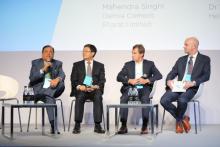
During its Capital Markets Day today in Copenhagen, Denmark,
“With economic growth, urbanisation and growing populations comes the demand for infrastructure, such as housing, schools, hospitals and roads. Added to this, modern conveniences such as air conditioning, appliances and smartphones are high in demand, and renewable energy options such as electric cars, wind and solar energy are looked to as the future. All of that requires cement and minerals, and demand will only continue to rise. Today, we launch MissionZero to seize the opportunity to increase production and at the same time drive emissions towards zero,” said Thomas Schulz, Group CEO, FLSmidth.
Central to MissionZero is FLSmidth’s focus on enabling its customers in cement and mining to move towards zero emissions in 2030. The company will do so by leveraging the development of digital and innovative solutions tied to sustainable productivity, offering its customers the required technological solutions to:
• operate zero emissions cement plants by 2030
• manage zero emissions mining processes by 2030 – with specific focus on water management.
FLSmidth estimates that it can reduce the CO₂ emissions per kg cement by approximately 70% by 2030 by leveraging opportunities within existing pioneering technologies, innovation projects and early-stage R&D. To achieve this, the company is developing solutions such as blending clinker with alternative materials, exploring the use of new types of cements and providing solutions to cement producers to operate 100% alternative fuelled cement plants including waste-to-energy solutions.
In addition, FLSmidth will accelerate solutions to close the remaining gap (30%). As these solutions do not exist today, FLSmidth will actively seek knowledge partnerships with other companies and suppliers to co-create solutions.
Water is a scarce resource in many parts of the world and represents a rising cost for FLSmidth’s mining customers. The company has set a goal to offer its customers solutions that support zero water waste by 2030, building on the success of recent developments, such as its dry-stack tailings solution (DST). Utilising DST can recover up to 95% of process water while being economically competitive with alternative water management options such as desalination, even for high tonnages.
Ambitious goals require collaborative efforts ”With MissionZero, we commit to our most ambitious goals to date. We are doing it because it is necessary, because it is sound business, and because it provides us with a competitive edge. We are the go-to-partner for sustainable productivity, and are perfectly positioned to address the challenges our customers face such as rising costs, tighter regulations and increased societal expectations. MissionZero goes beyond what is feasible today, and requires a paradigm shift in how industry players collaborate and innovate. As a leader in the cement and mining industries, we have a responsibility to accelerate the adoption of sustainable solutions,” said Schulz.
Underlining its commitment to drive sustainable solutions, FLSmidth was among the first companies to join the GCCA’s Innovandi - Global Cement and Concrete Research Network. This new network brings together the cement and concrete industry with scientific institutions to drive and support global innovation with actionable research. Its aims to decisively build on the industry’s sustainability progress with the focus on reducing emissions and achieving better use of alternative fuels.








